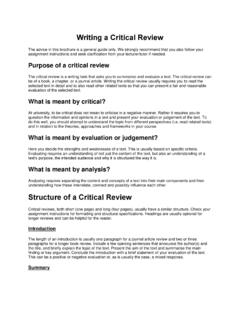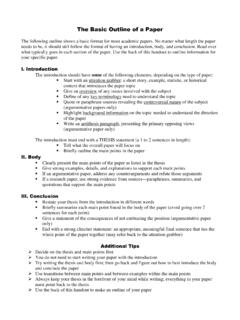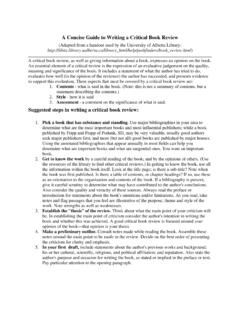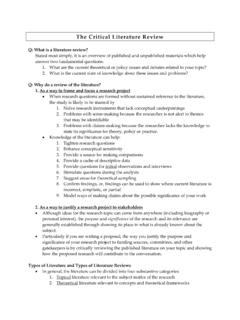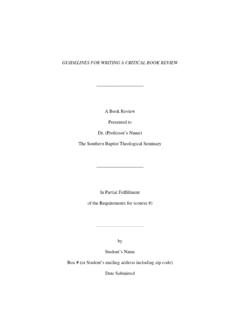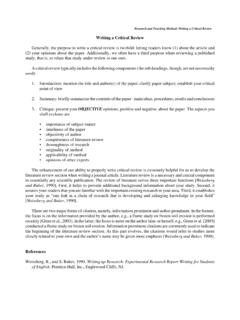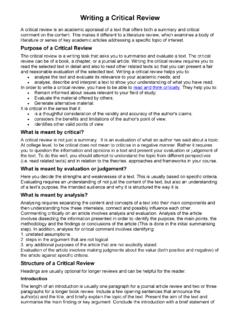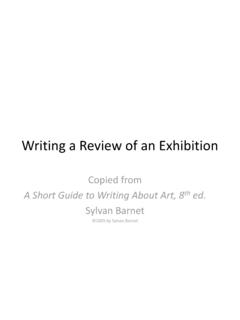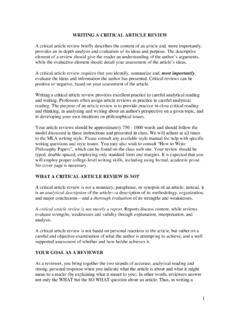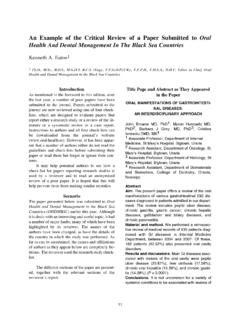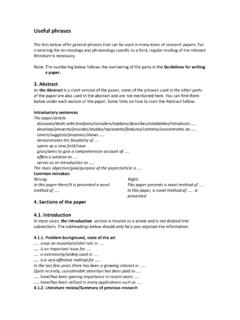Transcription of Writing a Critical Review - Academics
1 Writing a Critical Review The advice in this brochure is a general guide only. We strongly recommend that you also follow your assignment instructions and seek clarification from your lecturer/tutor if needed. Purpose of a Critical Review The Critical Review is a Writing task that asks you to summarise and evaluate a text. The Critical Review can be of a book, a chapter, or a journal article. Writing the Critical Review usually requires you to read the selected text in detail and to also read other related texts so that you can present a fair and reasonable evaluation of the selected text. What is meant by Critical ? At university, to be Critical does not mean to criticise in a negative manner. Rather it requires you to question the information and opinions in a text and present your evaluation or judgement of the text. To do this well, you should attempt to understand the topic from different perspectives ( read related texts) and in relation to the theories, approaches and frameworks in your course.
2 What is meant by evaluation or judgement? Here you decide the strengths and weaknesses of a text. This is usually based on specific criteria. Evaluating requires an understanding of not just the content of the text, but also an understanding of a text s purpose, the intended audience and why it is structured the way it is. What is meant by analysis? Analysing requires separating the content and concepts of a text into their main components and then understanding how these interrelate, connect and possibly influence each other. Structure of a Critical Review Critical reviews, both short (one page) and long (four pages), usually have a similar structure. Check your assignment instructions for formatting and structural specifications. Headings are usually optional for longer reviews and can be helpful for the reader. Introduction The length of an introduction is usually one paragraph for a journal article Review and two or three paragraphs for a longer book Review .
3 Include a few opening sentences that announce the author(s) and the title, and briefly explain the topic of the text. Present the aim of the text and summarise the main finding or key argument. Conclude the introduction with a brief statement of your evaluation of the text. This can be a positive or negative evaluation or, as is usually the case, a mixed response. Summary Present a summary of the key points along with a limited number of examples. You can also briefly explain the author s purpose/intentions throughout the text and you may briefly describe how the text is organised. The summary should only make up about a third of the Critical Review . Critique The critique should be a balanced discussion and evaluation of the strengths, weakness and notable features of the text. Remember to base your discussion on specific criteria. Good reviews also include other sources to support your evaluation (remember to reference).
4 You can choose how to sequence your critique. Here are some examples to get you started: Most important to least important conclusions you make about the text. If your critique is more positive than negative, then present the negative points first and the positive last. If your critique is more negative than positive, then present the positive points first and the negative last. If there are both strengths and weakness for each criterion you use, you need to decide overall what your judgement is. For example, you may want to comment on a key idea in the text and have both positive and negative comments. You could begin by stating what is good about the idea and then concede and explain how it is limited in some way. While this example shows a mixed evaluation, overall you are probably being more negative than positive. In long reviews, you can address each criteria you choose in a paragraph, including both negative and positive points.
5 For very short Critical reviews (one page or less) where your comments will be briefer, include a paragraph of positive aspects and another of negative. You can also include recommendations for how the text can be improved in terms of ideas, research approach; theories or frameworks used can also be included in the critique section. Conclusion & References Conclusion This is usually a very short paragraph. Restate your overall opinion of the text. Briefly present recommendations. If necessary some further qualification or explanation of your judgement can be included. This can help your critique sound fair and reasonable. References If you have used other sources in you Review you should also include a list of references at the end of the Review . Summarizing and paraphrasing for the Critical Review Summarising and paraphrasing are essential skills for academic Writing and in particular, the Critical Review .
6 To summarise means to reduce a text to its main points and its most important ideas. The length of your summary for a Critical Review should only be about one quarter to one third of the whole Critical Review . The best way to summarise is to: 1. Scan the text. Look for information that can be deduced from the introduction, conclusion and the title and headings. What do these tell you about the main points of the article? 2. Locate the topic sentences and highlight the main points as you read. 3. Reread the text and make separate notes of the main points. Examples and evidence do not need to be included at this stage. Usually they are used selectively in your critique. Paraphrasing means putting it into your own words. Paraphrasing offers an alternative to using direct quotations in your summary (and the critique) and can be an efficient way to integrate your summary notes.
7 The best way to paraphrase is to: 1. Review your summary notes 2. Rewrite them in your own words and in complete sentences 3. Use reporting verbs and phrases (eg; The author , Smith argues that ..). 4. If you include unique or specialist phrases from the text, use quotation marks. Some General Criteria for Evaluating Texts The following list of criteria and focus questions may be useful for reading the text and for preparing the Critical Review . Remember to check your assignment instructions for more specific criteria and focus questions that should form the basis of your Review . The length of the Review / assignment will determine how many criteria you will address in your critique. Criteria Possible focus questions Significance and contribution to the field What is the author's aim? To what extent has this aim been achieved? What does this text add to the body of knowledge?
8 (This could be in terms of theory, data and/or practical application) What relationship does it bear to other works in the field? What is missing/not stated? Is this a problem? Methodology or approach (this usually applies to more formal, research-based texts) What approach was used for the research? (eg; quantitative or qualitative, analysis/ Review of theory or current practice, comparative, case study, personal reflection ) How objective/biased is the approach? Are the results valid and reliable? What analytical framework is used to discuss the results? Argument and use of evidence Is there a clear problem, statement or hypothesis? What claims are made? Is the argument consistent? What kinds of evidence does the text rely on? How valid and reliable is the evidence? How effective is the evidence in supporting the argument?
9 What conclusions are drawn? Are these conclusions justified? Writing style and text structure Does the Writing style suit the intended audience? (eg; expert/non-expert, academic/non-academic) What is the organising principle of the text? Could it be better organised?
